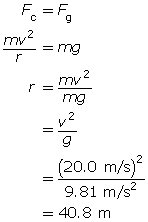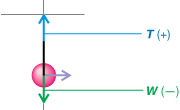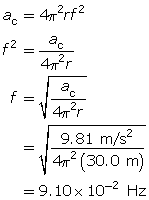Module 5—Circular Motion
 Read
Read
How do you explain the weightless feeling you get on a roller coaster during an upside-down loop? Read “A Vertical System in Circular Motion” on pages 260 to 262 of the physics textbook to get some answers.
 Self-Check
Self-Check
SC 7. Complete question 2 of “Practice Problems” on page 262 of the textbook.
 Self-Check Answers
Self-Check Answers
SC 7.
Given
v = 20.0 m/s
Required
the maximum radius of the loop (r)
Analysis and Solution
For the car to remain on the track at the top of the loop without hanging by its wheels, the centripetal force must be at least equal to the force of gravity. Equate the two forces and solve for the radius (r).

Paraphrase
The maximum radius of the loop for the car to go around safely is 40.8 m.
Case 2: At the Bottom of the Arc
 Self-Check
Self-Check

SC 8. This figure shows the ball at the bottom of the arc. At the infinitesimal instant that the ball is at the bottom of the circle, all of the forces are acting vertically. Define the positive direction as upward, and carefully label the tension force and weight force on this diagram. What direction does each of these forces have in this case? Use + or − to label the direction on the diagram.
SC 9. The inward force is the force needed to deflect the ball in a circular path. At the bottom of the arc, Finward is the net force or sum of the weight and tension forces.
- Using the FBD constructed in SC 8, write an equation for Finward.
Finward = _______ + _______
- What is the direction of the inward force at the bottom of the arc?
- Rewrite the Finward equation, and include the direction for all of the forces. (Notice that at this infinitesimal instant, all of the forces are along the y-axis; so, you can use + or – to represent direction.)
_______ = (_______) + (_______)
- Manipulate this expression in terms of the tension force (T) in the rod.
T = _______ + ________
- An inward force can also be defined by the expression
 . Remember that weight is defined as W = mg. Rewrite the equation from SC 9.d. by substituting these expressions into it.
. Remember that weight is defined as W = mg. Rewrite the equation from SC 9.d. by substituting these expressions into it.
 Self-Check Answers
Self-Check Answers
SC 8.

SC 9.
- Finward = W + T
- positive
- (+ Finward) = (– W) + (+ T)
- T = (+ Finward) + (+ W)

Explore the tension at the bottom of a vertical circular motion in this tutorial Vertical Circular Motion: Forces at the Bottom.
In order to complete this tutorial, you must have Authorware Player, which you will have downloaded for the previous two tutorials.
The tutorial uses the term Finward for the centripetal force vector, ![]() , and omits the vector signs above the symbols. It states that they are vectors and adds them like you should for a vector.
, and omits the vector signs above the symbols. It states that they are vectors and adds them like you should for a vector.
In screen 8, if you can’t see the second-last quantity asked for, it is the acceleration due to gravity, g.
 Read
Read
To get a summary of what you have learned about forces in circular motion so far, read from the bottom of page 262 through page 264 of the physics textbook.
Comparing the Different Forms of the Tension Equation
The textbook uses the following formula for the magnitude of the tension at the bottom of the circle:
![]() (It substitutes (+9.81 m/s2) for g.)
(It substitutes (+9.81 m/s2) for g.)
The tutorial uses the following vector equation, even though the vector signs are not used:
![]()
The tutorial substitutes in –9.81 m/s2 for g. Can you see that gives an equivalent result to the text because subtracting a negative number is the same as adding a positive number?
In SC 9.e. you arrived at the following equation for the magnitude of the tension at the bottom of the circle:
![]()
There you use +9.81 m/s2 for g because you are again dealing with magnitudes. Can you see that it will give an equivalent result to the other two equations?
The important thing to know is that the magnitude of the tension at the bottom of the circle is larger than the magnitude of centripetal force because the force of gravity must be added. At the top of the circle, the magnitude of the tension is smaller than the magnitude of the centripetal force because the force of gravity must be subtracted. At the horizontal positions on either side of the circle, the tension is equal to the centripetal force because the force of gravity is exactly perpendicular to the tension and the centripetal force.
 Self-Check
Self-Check
SC 10. Re-start the Circular Motion: Vertical simulation, if necessary. Set up the following conditions in the simulation. (The mass and radius settings can be adjusted by moving the sliders. Double-clicking the slider or clicking (![]() ) allows you to enter an exact value for the variable.)
) allows you to enter an exact value for the variable.)
- mass of the ball = 2.0 kg
- initial velocity = 12.0 m/s
- radius of the arc = 2.0 m
Press “Play.” Then press “Pause” when the ball is near the bottom of the arc. Click the ball, and position it at the exact bottom of the arc so the angle shows 270.0°.
- Record the speed at the bottom of the arc: ______ m/s
- Calculate the expected tension in the rod at the bottom of the arc by doing the following:
- State the equation you derived in SC 9.e.
- Calculate the tension acting at the bottom of the vertical loop using the mass, radius, and velocity at the bottom of the arc.
- Verify your answer by checking the tension measurement on the simulation when the ball is positioned at the bottom of the arc.
tension measurement: _______ N
 Self-Check Answers
Self-Check Answers
SC 10.
- speed = 12. 0 m/s


- tension measurement: 163.62 N
 Module 5: Lesson 2 Assignment
Module 5: Lesson 2 Assignment
Remember to submit the answer to TR 5 to your teacher as part of your Module 5: Lesson 2 Assignment.
 Try This
Try This
TR 5. Complete question 3 in “Practice Problems” on page 264 of the textbook.
 Read
Read
What happens when the rate of rotation is given as frequency or period instead of speed? How are the circular motion equations adapted to accommodate this? Read “Centripetal Force, Acceleration, and Frequency” on pages 265 to 267 of the physics textbook.
 Self-Check
Self-Check
SC 11. Complete question 1 of “Practice Problems” on page 267 of the physics textbook.
 Self-Check Answers
Self-Check Answers
SC 11.
Given
r = 30.0 m a = 9.81 m/s2
Required
the frequency of rotation of the space station (f)
Analysis and Solution
The centripetal acceleration of the space station must equal the acceleration due to gravity. Rearrange the centripetal acceleration formula to solve for frequency.

Paraphrase
The frequency of rotation of the space station must be 9.10 × 10–2 Hz.